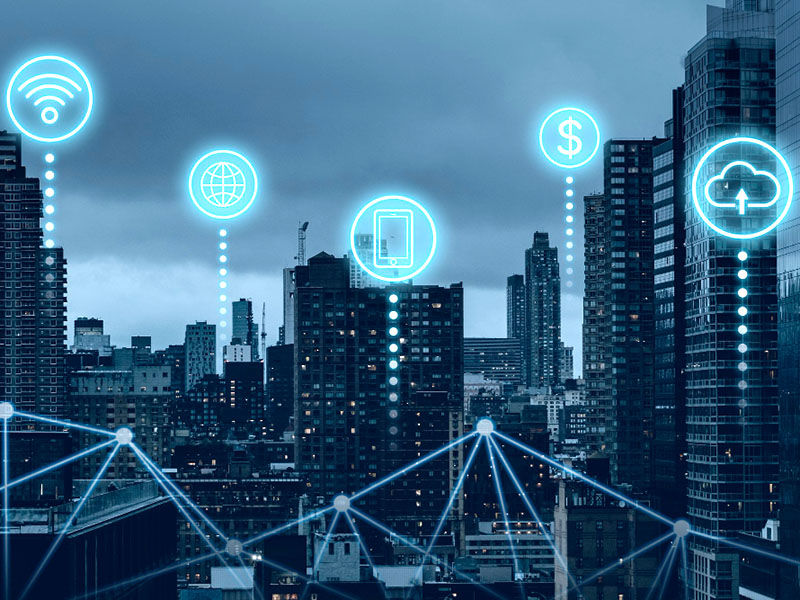QUIC, the new official network protocol to replace TCP
04/06/2021QUIC, the network protocol designed by Google, has been presented by the Internet Engineering Task Force, IETF, as a new official Internet standard to replace TCP, the current main standard. Google's QUIC (Quick UDP Internet Connections) network protocol is designed to reduce latency with retransmissions taking less time, potentially reducing the waiting time for search results by 8% on computers and 4% on mobile devices, according to the paper released by Google in 2017. QUIC will replace TCP, the current main standard of the Internet since 1974 - when it was still Arpanet - and on which the operation of Internet elements such as the World Wide Web (WWW) logic system, file transmission, 'emails' and remote administration depend. The new QUIC protocol has already been published by the IETF, making it an official network protocol.
[ ... ]WiFi Security: Assessment of threats in wireless networks
08/03/2024Wifi connectivity has gone from being limited to restricted environments to becoming omnipresent in virtually every aspect of our daily lives. The ability to connect to the Internet from anywhere, be it at home, in a café, at work, in public spaces, or even in-flight, has enhanced the convenience in our daily lives. Moreover, the expansion of Wifi networks and the use of new manufacturing technologies now allow the interconnection of devices, leading to the significant rise of the Internet of Things (IoT) and providing users with more comprehensive control over their digital environments. However, this proliferation of Wifi networks has also given rise to new threats that require careful evaluation and effective security strategies to ensure secure and risk-free Wifi connections for our data and information. Common Wifi security threats include data interception Man-in-the-Middle (MITM) attacks One of the fundamental challenges in Wifi security is preventing MITM attacks, where an intruder inserts themselves into the communication between two parties, compromising the integrity and confidentiality of sensitive data such as passwords and financial information. Spoofing of access points Hackers can create fake Wifi networks that mimic legitimate ones to attract unsuspecting users. Once connected to these malicious networks, our data can be captured by cybercriminals who may sell or misuse it for illicit purposes. Tips for achieving a secure Wifi connection: Strengthen authentication and use security protocols Prioritize strong encryption for networks to protect confidential information transmitted through it. WPA (Wifi Protected Access) encryption uses stronger algorithms than its predecessor, WEP (Wired Equivalent Privacy), making it more difficult for hackers to intercept and decipher data. Advanced security protocols like WPA3 provide individualized data encryption and advanced two-factor authentication (2FA) methods, adding an extra layer of security by requiring additional verification. Device management Properly manage and monitor devices connected to Wifi networks to minimize risks associated with the large number of connected devices in homes and businesses. Regularly update the router firmware and all connected devices to address potential vulnerabilities. Segmentation of the network to separate critical devices from less secure ones also helps mitigate the risk of threat propagation. Secure Router Configuration The router secure configuration is what will ensure the robustness and overall security of a wireless network. The router, being the first point of contact for devices connected to the Internet, acts as the first line of defence against potential attacks. For this reason, it is important to understand that the proper configuration of the router not only guarantees a stable and efficient connection but also establishes a protected environment that safeguards the integrity and privacy of our data. How to configure the router securely? To ensure a correct and secure configuration of the router, it is recommended to: Change the default username and password of the router, as these are easily accessible to attackers. Use strong passwords containing a combination of letters, numbers, and special characters. Disable remote administration to prevent cybercriminals from accessing the router externally. Enable WPA2 or WPA3 encryption instead of the outdated WEP for enhanced network security. Optionally, disable SSID broadcast to make the network less visible and harder to detect by hackers. Keep the router firmware updated to address vulnerabilities and improve overall device security. By following these steps, you will strengthen the security of your wireless network and reduce the chances of experiencing unwanted attacks or intrusions.
[ ... ]Private Internet Access
Private Internet AccessThey call it PIA, which is the same as Private Internet Access but shortened. At PIA, it's all about online privacy. As a good VPN provider, it strives to give users online privacy, security, and freedom. To do so, they abide by strict and reliable open-source VPN protocols and a clear no-logging policy. Based in the United States, PIA has more than 10 years of experience leading the VPN industry, and they are considered true experts when it comes to providing online security and anonymity.
[ ... ]How can I hide my IP?
Accessing the Internet involves connecting our computer, smartphone, tablet, etc. to a communications server that is responsible for providing access to the network. This connection involves the identification and exchange of data about our identity, IP address, and online activities that are recorded forever as a trace of our navigation. Can I be tracked through my IP address? Yes, it is possible to trace an IP address and for those who consider privacy a priority, this is a major problem because, in addition to being exposed throughout the network, the increasingly intensive use of the Internet has led to this type of data becoming an object of interest for cybercriminals seeking personal or confidential information that can be used for their benefit. To safeguard against all this, there are several methods to hide the IP address, ensure our online privacy, improve our security on the Internet, and prevent anyone from knowing what pages we visit, the time we have spent on every connection, or what we are downloading. What are the advantages of hiding my IP? Apart from everything related to privacy and security already mentioned, hiding the IP offers different advantages for users in multiple circumstances: There are IP hiding services that prevent IP geolocation when we travel and allow us to connect to the network as if we were doing it from our own country, overcoming, for example, any network access limitations that may exist in the place where we are. We will be able to download files anonymously avoiding that the rest of the users can see our IP location. If our IP is not "in sight", the possible limitations and blockages of the Wi-Fi network and even of our ISP (Internet Service Provider) disappear. Thanks to the data encryption system of the most advanced IP hiding services, our vulnerability in connections to public Wi-Fi networks is minimized. When the system detects a location different from the real one, this can give us advantages to buy in online stores with different offers according to the country or to avoid the blocking of games, maps, and online game add-ons that may have restrictions on our location. How can I hide my IP? IP hiding is achieved through the use of specific services and tools to hide the IP and encrypt our traffic, those services allow us to hide the real communications we make during our navigation. Besides those techniques that are based on the modification of network protocols and require certain skills to carry them out, there are several technologies within the reach of all users: VPN or Virtual Private Network Proxy or Web proxy Tor Public Wifi How to hide the IP address with a VPN? VPNs are services that connect us to the Internet through intermediate servers, in which our original IP address is " masked " by the IP address of that secure server. This concealment ensures that anyone tracing our connection will only see the IP address and location of the VPN server, but not our own. In addition, to safeguard our activity on the network, VPNs use tunneling and data encryption, encrypting the information we exchange with the VPN server, hiding it, and preventing third parties from being able to read it during its transit. The security of VPN connections is determined by proprietary VPN protocols, based on different standards and encryption and authentication methods, which depend on each developer. The range of options is wide and this allows us to choose between, for example, options that prioritize speed over security, options that do the opposite, options with a greater or lesser degree of reliability, etc. VPN applications always run in the background and do not hinder browsing. How to use a proxy server to hide the IP address? Unlike VPN services, proxy servers focus their activity solely on hiding the IP, without performing any type of concealment on our network traffic or any other data that could reveal our identity. Proxy servers act as intermediaries between our device and the destination server to which they transmit our requests on our behalf. Therefore, our IP will be hidden and the only one they will see will be the proxy one. There are different types of proxy services, from the simplest ones that only help us to hide the IP to others with extra functionalities such as blocking cookies, scripts, and other files hosted on websites and sent to the user. Browsers or applications based on the HTTP protocol offer the manual proxy configuration function so that we can indicate the proxy web address and port to which we want to connect before browsing. In this way, any activity that we perform through that browser will always be routed to the proxy. Alternatively, you can also opt for the automatic proxy format that searches through DNS or DHCP for the URL from which to download the wpad.dat file that runs and allows the proxy connection with automatic authentication on your computer. How to hide your IP with Tor? Tor is a free software developed to ensure anonymous browsing of users on the Internet. To mask the IP Tor uses a network of volunteer computers or nodes through which it redirects our traffic and encrypts it before it reaches its destination. At least this redirection goes through three of these nodes, achieving repetitive re-encryptions so that any possible clue about our identity disappears. In this process, Tor assigns a random and geographically different IP to our connection so that the location by third parties is impossible (if you are curious to know the IP you have been assigned you can check it through our tool). This system allows different configurations depending on whether we are using a firewall, if our ISP is blocking Tor connections or if we navigate through proxy for example. Can I hide my IP with a public Wi-Fi connection? The answer is yes. A public Wi-Fi network can also be used to hide our IP address, although if we do not have it constantly at our disposal, the IP hiding is limited to the time we have access to a public network. As this type of network is a connection shared by many other people, this makes it impossible to trace a particular user or identify them on the destination server. However, it is precisely this general access that also makes us more vulnerable. And although through a connection to a public Wi-Fi we will solve the issue of IP hiding, security will never be total, because being an open network, we can be exposed to the will of hackers and other threats, including malware and viruses. And if I want to hide my IP address, how can I change it? It may also be the case that instead of masking the IP all we need to do is change our IP address at a given moment. Then, the solution is as simple as disconnecting the modem from the power supply and restarting it after a few minutes. In that time, if your IP address is dynamic (you can check it through the network connections tab on your computer), it will be deleted and your Internet provider will give you a new one. To make sure that everything went well, we recommend doing something as simple as writing down the IP address before turning off the router and checking it again once it is up and running again. Another possible way to achieve the same result if you have a smartphone with a data plan is to turn this device into a wireless access point to which you can connect your computer, thus hiding your usual connection. There are many options to hide the IP or to change it and now that you know how each of them works you will be able to decide which one suits you best.
[ ... ]What is Bitcoin Halving and how does it affect the cryptocurrency?
25/02/2024The term "Halving" in the context of Bitcoin refers to a scheduled event in the cryptocurrency protocol, in which the reward for mining blocks is reduced by half. This event occurs approximately every four years and has a significant impact on the supply and demand of Bitcoin. During Halving, the number of new Bitcoins created per block is halved. This implies a decrease in the issuance rate of the cryptocurrency, which in turn can have an effect on the price and volatility of Bitcoin. Many analysts and experts are speculating about the long-term implications of the Halving and its influence on the cryptocurrency markets. Services related to Bitcoin Halving There are various types of services and tools related to Bitcoin Halving that can be beneficial for different actors in the cryptocurrency ecosystem. These services include: 1. Halving analysis and forecast This type of service provides detailed information about the past, present and future of the Bitcoin Halving. Through analysis and forecasting, it helps investors and cryptocurrency enthusiasts make informed decisions on how to position themselves before and after the event. 2. Bitcoin Mining As the reward in Bitcoin decreases, mining this cryptocurrency becomes more challenging. Bitcoin mining services offer solutions and advice to maximize mining efficiency and profitability, even in a low reward environment. 3. Financial advice related to Halving As the issuance rate of Bitcoin slows, investors may need to adapt their investment strategies. Financial advisory services specialized in cryptocurrencies and Bitcoin provide personalized recommendations and analysis to optimize investment performance in this context. 4. Development of tools for cryptocurrencies The Bitcoin Halving may generate changes in the cryptocurrency ecosystem, which may require the creation of new tools and solutions. Companies specialized in software development and applications related to cryptocurrencies can provide development and consulting services to adapt to these new demands. Bitcoin: Reward Reduction and Its Implications on the Cryptocurrency Ecosystem Bitcoin, the most famous and valuable cryptocurrency in the world, has periodically experienced an event known as a "reward reduction" or "Halving", which has significant implications on the cryptocurrency ecosystem. In this article, we will explore in depth what Bitcoin reward reduction is and how it affects both miners and investors. What is Bitcoin reward reduction? Bitcoin reward reduction is a scheduled event integrated into the cryptocurrency protocol. It occurs approximately every four years and consists of a halving of the reward miners receive for validating transactions and adding new blocks to the Bitcoin blockchain. Originally, when Bitcoin was launched in 2009, miners received a reward of 50 Bitcoins for each block mined. However, due to the reward reduction process, this amount has decreased over time. In 2012, it was reduced to 25 Bitcoins per block, in 2016 to 12.5 Bitcoins per block, and in 2020 it was reduced again to 6.25 Bitcoins per block. Implications for Bitcoin miners Bitcoin's reward reduction has a significant impact on mining the cryptocurrency. With each reduction, miners receive fewer Bitcoins for their work, which means less direct monetary reward. This may result in some miners leaving the Bitcoin network, especially those with higher electricity and mining equipment costs. On the other hand, those miners who manage to adapt and remain profitable even with a lower reward are rewarded with a larger share of the Bitcoin supply generated through mining. This concentration of Bitcoins in the hands of fewer miners can have effects on the decentralization and security of the network, since the number of active participants in the transaction validation process is reduced. Implications for investors and the price of Bitcoin Bitcoin's reward reduction also has implications for the price and supply of the cryptocurrency. As the issuance of new Bitcoins decreases, the supply in the market reduces. This may lead to higher relative demand if Bitcoin demand continues to grow or remains stable. In previous reward reduction events, a long-term increase in Bitcoin price has been observed. This is because the decrease in the supply of new Bitcoins can lead to greater perceived scarcity and therefore an increase in their value. However, it is important to note that the price of Bitcoin is highly volatile and can be influenced by a variety of external factors, so a continued increase after reward reduction cannot be guaranteed. Bitcoin's reward reduction is a key event in the life of the cryptocurrency and has implications for both miners and investors. As the number of new Bitcoins generated is halved, miners must adapt to remain profitable and the supply of Bitcoin on the market may decrease. However, this event can also have a positive impact on the price of Bitcoin in the long term. It is important to understand and take these factors into account when evaluating investment potential in Bitcoin and the cryptocurrency market in general. Bitcoin and limited supply: a unique combination Bitcoin has captured the attention of the financial world like no other cryptocurrency. One of its most notable features is its limited supply, meaning that only a finite number of bitcoins will be created in the world. This contrasts with traditional fiat currencies, which can be printed at the discretion of governments. How does Bitcoin limited supply work? Bitcoin was designed to have a total supply of 21 million coins. As new blocks are mined by users and added to the Bitcoin blockchain, new coins are generated and distributed as rewards to miners. However, this reward is halved in an event known as "Halving", which occurs approximately every four years. Halving ensures that the rate of issuance of new bitcoins decreases over time, following a predictable mathematical function. Currently, the reward per mined block is 6.25 bitcoins, but this number is expected to reduce further in the future. This controlled scarcity mechanism is a central part of Bitcoin's monetary policy. Advantages of Bitcoin Limited Supply Bitcoin's limited supply has several significant advantages: Sense of scarcity: The limitation in the supply of Bitcoin makes it a scarce and valuable asset. As it approaches its maximum supply, demand and price are expected to increase. Inflation Protection: Unlike fiat currencies, Bitcoin cannot be inflated or devalued at the discretion of governments. Its limited supply protects it from inflation and makes it a safe store of value. Monetary stability: With carefully controlled supply, Bitcoin offers greater monetary stability compared to national currencies, which can be affected by political and economic decisions. Challenges and debates surrounding the limited supply of Bitcoin Despite the advantages, Bitcoin's limited supply has also generated debates and challenges. Some argue that the scarcity of bitcoins could hinder its mass adoption as an everyday currency. Price volatility is also an issue of concern. Furthermore, the fact that only about 80% of all existing bitcoins have been mined raises questions about how the latest bitcoins will be distributed and how this will affect the network and its sustainability in the future. Bitcoin has revolutionized the financial world with its limited supply and unique monetary policy. Controlled and predictable scarcity is an essential part of its design, providing a solid alternative to traditional fiat currencies. Although limited supply can pose challenges and debates, it also offers significant benefits, such as a sense of scarcity, protection against inflation, and monetary stability. As Bitcoin continues to mature and its supply approaches its maximum limit, its value and relevance in the financial world continues to grow, leaving investors and enthusiasts with great anticipation about its future.
[ ... ]Ip Location, the tool to know my ip location
If you need to check what location your internet provider is sharing with the websites you visit, with our IP locator you can instantly geolocate your IP address or any other that you enter manually. To geographically locate the IP address, you only need to be connected to the internet. If you use VPN software or connect through a proxy to locate IP address you can also use our tool. None of the data generated by the IP locator is stored in our system. @Mapa@ How can I hide my IP address so that it cannot be traced? To anonymously browse the Internet and avoid being located through the IP of your connection, there are two basic ways to do it. The first is to hide IP so that no one will be able to track our presence on the network or access our browsing data and the second is to change IP and browse through another IP address whenever we need to. Why do I need to locate my IP geographically? Locating your IP geographically is the best way to find out what data our ISP shares about the location of our connection. Depending on this location. a website whose URL is ".com" will change to "/es" if we connect from Spain, for example, and some tasks related to the sending of forms will be simplified, as they will be automatically pre-filled with some data such as your country or city, depending on your geolocation IP. As users with a geolocation IP tool such as the one we offer in Cuál es mi IP, we can manually enter an IP address and find out, for example, from where we have received a fraudulent email, if we have had access before, of course, to the IP address involved Can anyone find out my home address with an IP geolocation tool? By using a tool to locate an IP address, you can trace the IP and geolocate it through coordinates on the map, but the specific postal address is never provided. This is because our IP address is not ours, but rather our Internet Service Provider's (ISP's). So what data can they find out about me with IP geolocation? When locating the IP geographically. the only information about us that is provided is the country and city from which we are connecting, since the GPS coordinates of altitude and latitude that are shown correspond, in reality, to those of the headquarters of the company that is offering us the Internet connection service. The reason behind this is that all data related to the actual geographic address of the device used to access the Internet, i.e. our router, is not public and belongs to our ISP, which can only disclose it by court order. Why are companies interested in locating my IP address geographically? Information is power and for a company to know from where its potential customers connect is an important advantage to design marketing strategies aimed at the customer profile of a particular geographical area or country. In addition, in terms of anti-fraud, e-commerce companies can improve card payment security by identifying payment attempts from suspicious IP addresses. What is an IP address? An IP address is a special numerical combination assigned to an internet-connected device to be identified on the network. All intelligent devices need an IP address to access the Internet and interact on the network. Each device connected to the Internet has its own an individual IP address. When we access the Internet, the servers recognize our device through its IP address, allowing the two-way communication with the recipient. As we are identified with our IP address, the rest of devices can order a return response, without mistake the sender. Making a simile, an IP address would be the address that we use to write on the back of an envelope. This information identifies us as issuers and also as recipients of the return answer. To make possible this data exchange, the IP protocol was established as a set of universal rules for all the Internet operations. That means that all devices connected to Internet or to a home network, "speak" the same language and they are able to communicate each with the others. There are two types of IP address, the external IP and the local IP: • The external IP or public IP is the numerical combination address assigned to us by our Internet service provider (ISP). This public IP identifies us as Internet users when we are connected. If you want to find the IP of your computer, your tablet or your Smartphone, you can find out this immediately by accessing the home page of “What is my IP” or using our speed test service that, in addition to this information, will inform you about the quality of your Internet connection. • The local IP address or internal IP is the one the router assign to all the devices connected to him and identifies each of these devices, individually, in the home network. How to locate an IP address? If you want to know how to find out where an IP address is from, you should know that it is not always easy to find out the IP origin of a connection, because there are different systems to hide the IP. Some users use these systems for security reasons or to simulate, for example, their IP location in another place and thus have access to Internet services not enabled in the place where they are located. Now, if the user does not use any resource to mask the IP, find out the IP of the computer or any other device connected, for example, to our website, it is as simple as use IP geolocation services such the one offered in “What is my IP?” and you will immediately find out the IP origin of any computer that you are interested in track. Knowing the IP location of our clients is an advantage when we are designing, for example, our marketing strategies and a good tool, also, to improve network security, as it allows us to locate suspicious IP addresses. In addition, with the IP geolocation service you can also verify the location that your Internet provider shares about you. It should be clarified that this location provided by IP geolocation services is never the specific address of our home or where we are located. The data actually are from the operator node in our area that is offering us the connection service to the internet network Therefore, the geolocation information will be the country and city from where the connection is made, but not the address where the user is located, because this specific tracking of the user address is protected by law and this data can only be provided by court order.
[ ... ]OPPO joins the Connectivity Standards Alliance
21/10/2021Oppo has announced its membership on the Board of Directors of the Connectivity Standards Alliance (CSA), the organization with more than 400 technology companies working together to increase compatibility in IoT through simpler technology standards. One of Oppo's main objectives in his new role, explained Neil Yang, director of OPPO's Standards Research Department, is to promote Matter, the base protocol for the Internet of Things (IoT), offering a simplified user experience that allows connecting different devices "We want to create a highly compliant IoT ecosystem, and drive the development of the Alliance's advancements together with other partners through proposals for new protocols, setting new standards and developing new Matter-based products”, says Yang. For the CSA, Oppo's commitment is an open door to promote Matter in China and throughout Asia, offering the possibility of providing better IoT experiences to more than one billion users.
[ ... ]Speed Test
Check your internet speed and latency with this test and find out how good your connection is. Compatible with Fiber and ADSL connections. With our speed test, you can assess the quality of your connection quickly and reliably. This test does not only allow you to determine your upload and download speed but also the latency, i.e., the amount of time it takes for a packet of data to travel from one designated point to another. Besides, you can use it to find out the ASN of your internet provider and which IP protocol version you are using (IPv4 or IPv6). To check your internet speed and the rest of the parameters, just click on "Start Test" and, within a few seconds, you will be able to see a summary of the results on your screen. In addition, while the speed test is running, a real-time graph will show you how your connection is performing. For an optimal measurement, it is recommended to use a cable connection, rather than a Wi-Fi or PCL one. Likewise, it is advised to stop any ongoing downloads on the computer on which the internet speed test is running or on any other computer connected to it.
[ ... ]







